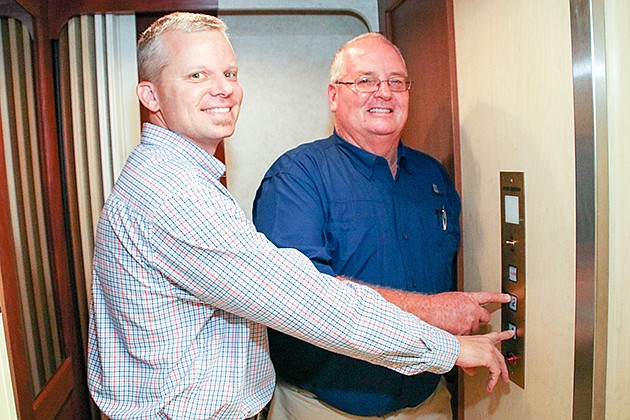- November 24, 2024
-
-
Loading

Loading

Once the province of super-luxury homes, the residential elevator is fast becoming a must-have appliance in multistory abodes.
Demand for residential elevators has grown as the population ages. Baby boomers are now caring for their elderly parents in multistory homes and need the lifts to ensure they can age in place.
“Nowadays you're seeing elevators in $300,000 homes,” says John Andrews, a longtime employee of Gulfside Elevator & Cab Interiors in Naples who became a co-owner of the firm with colleague Juston Ticknor last year. Andrews is president of operations and Ticknor is president of sales.
It's not just people who need a lift. “Customers say, 'My dog's getting old and can't go up the stairs,'” adds Ticknor.
Gulfside is the new incarnation of Taylor Elevator, co-founded by elevator veterans John Taylor and Bill Beaury in 1992. Taylor and Beaury sold the commercial division of their elevator company to elevator giant Otis Elevator last year, renamed the remaining part of the business Gulfside Elevator & Cab Interiors and added Andrews and Ticknor as co-owners. Now Andrews and Ticknor run the day-to-day operations of Gulfside Elevator.
Because homeowners want to age in place, an elevator can make the difference when property owners sell their homes, Andrews and Ticknor say. A custom-built Gulfside elevator can cost between $18,000 to $22,000, though the company has built more ornate ones with wrought iron and glass that cost as much as $75,000.
Andrews estimates Gulfside will sell as many as 150 residential elevators this year in the region that stretches from Sarasota to Marco Island. That's half the number the company sold during the boom — but more than double what it sold during the bust. Andrews estimates revenues will reach between $4.5 million to $5 million for 2016, the first full year in business under the new company ownership structure.
The elevator company also renovates the interiors of commercial-elevator cabs. Gulfside works with companies such as Otis and Oracle, coordinating the renovation of the interior of cabs in office buildings and condo towers with new fixtures such as panels and lights while those companies perform maintenance on the commercial lift systems. “That's a market we want to start pushing,” says Andrews.
But the majority of Gulfside's business is installation of new elevators in homes, and about 90% of those are in new construction. Gulfside can also install elevators in existing homes, and builders are designing homes today that can accommodate an elevator later. About 15% to 20% of Gulfside's business is servicing residential elevators.
Gulfside operates out of an 11,000-square-foot manufacturing facility in Naples. “We make all our own cabs here,” says Andrews. “Everything is custom.”
Having the manufacturing capability helps Gulfside control quality, tailor the cabs to customers' needs and respond quickly to demand. And Gulfside can control costs with its own labor and materials.
Like every building trade, new government regulations require elevator-cab makers to make costly changes, an ongoing industry challenge. For example, a new code will go into effect on Oct. 1 that requires changes to elevator door dimensions, which will add $500 to $800 in costs per elevator. “We'll do our best to absorb that,” says Andrews.